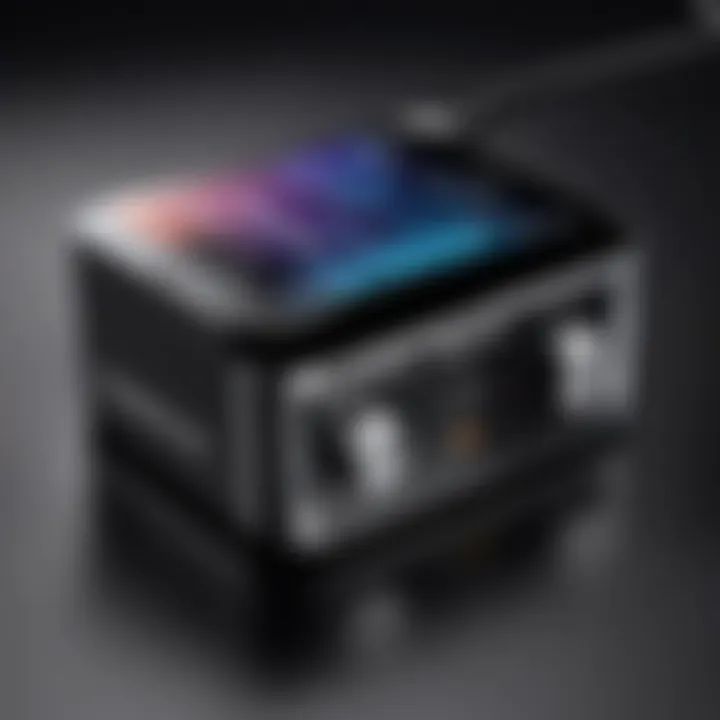Mastering Pandora's Equalizer on iPhone


Intro
The equalizer is a valuable tool that enhances audio playback and offers personalized sound experiences. For users of Pandora on iPhone, understanding and utilizing the equalizer means tailoring music to individual preferences. This feature can drastically affect sound quality, allowing for a customized listening experience. This article will guide you through the steps to access and optimize the equalizer settings.
Overview of the Technology
The equalizer technology allows users to modify the audio frequency response of music. By adjusting various frequency bands, users can emphasize or de-emphasize certain sounds, leading to a better overall listening experience.
Key specifications
The equalizer in Pandora offers several presets designed for different genres and moods. Users can access various options such as Rock, Pop, Jazz, Classical, and more. Each preset adjusts specific sound frequencies to enhance the corresponding genre’s audio representation. Additionally, users can create their own custom settings, fine-tuning the sound to match their unique preferences.
Unique selling points
One standout feature of the equalizer in Pandora is the ease of use combined with the technical depth it offers. This feature not only provides presets but also allows fine adjustments for discerning listeners. Accessing the equalizer settings is straightforward, making it accessible for both tech-savvy individuals and casual listeners alike.
Design and Build Quality
While the equalizer itself does not refer to a physical design, it is part of the overall interface of the Pandora application. The design is clean and user-friendly, allowing for an intuitive navigation experience.
Material used
The iPhone and its operating system contribute to the fluid experience of using Pandora. The application is designed to efficiently operate within iOS, ensuring that equalization tasks are seamless and responsive.
Ergonomics and usability
The usability of the equalizer features in Pandora makes it easy to experiment with various settings. Users can switch between presets and make adjustments without excessive navigation or complexity. This ergonomic approach to design encourages exploration, enabling users to discover the settings that best suit their listening habits.
"The equalizer enhances audio output, making each listening experience not just personal, but truly unique."
By appreciating the functionalities and qualities outlined above, one can fully utilize the equalizer feature of Pandora on iPhone. This understanding plays a pivotal role in enhancing one's musical experience, paving the way for hours of enjoyable listening.
Prelude to Audio Equalization
Audio equalization plays a critical role in how we perceive sound. It allows users to manipulate audio frequencies to enhance their listening experience. The importance of understanding this concept cannot be understated, especially for users of Pandora on iPhone, who seek to maximize the quality of their music.
Equalizers adjust various frequency bands within the audio spectrum. This means that by increasing or decreasing certain frequencies, listeners can tailor the sound to their preferences. Adjusting these frequencies can help in highlighting aspects of the music that might otherwise go unnoticed. For instance, boosting low frequencies enhances bass, while increasing high frequencies can bring clarity to vocals or instruments.
In the context of this article, we will explore several elements regarding audio equalization. We will discuss how to access equalizer settings on Pandora, the types of settings available, and their impact on overall sound quality.
Definition and Importance
Audio equalization refers to the process of balancing the relative levels of different frequency components of an audio signal. This is achieved through the use of an equalizer, which can be a standalone device or a feature within music applications like Pandora.
The significance of audio equalization lies in its ability to enhance the listening experience. Here are some important considerations about equalization:
- Customization: Each user has unique preferences for sound. An equalizer allows tailoring the audio to individual tastes, offering more personalized listening experiences.
- Sound Quality: Proper equalization can significantly improve sound quality. By adjusting frequencies, unwanted noises can be reduced, and specific sounds can be emphasized.
- Adaptability: Different types of music require different equalization settings. For example, jazz may benefit from different settings than rock music, showcasing the need for adaptability in equalization.
Understanding these aspects helps users of Pandora on iPhone make informed decisions regarding their equalizer settings. The ultimate goal is to optimize how music is experienced, leading to a deeper engagement with the audio content.
Overview of Pandora on iPhone
Pandora has carved out a notable position in the realm of music streaming. It is not just about playing songs; it creates a tailored listening experience. Understanding the application on iPhone is paramount for those who wish to fully utilize its potential. The overview section elucidates the key features and differentiators of Pandora, setting the foundation for those seeking to optimize their usage further.
Key Features of Pandora
Pandora distinguishes itself through several features that appeal to music enthusiasts. Here are some central aspects:
- Personalized Stations: One of Pandora's hallmark features is its ability to create personalized radio stations. Users can start a station based on a favorite song or artist. The algorithm then curates music that resonates with that selection.
- Music Genome Project: This is a unique algorithm that categorizes music by over 450 distinct attributes. It helps enhance the accuracy of music recommendations, making each listening experience unique and satisfying.
- Curated Playlists: For those who prefer more guided listening, Pandora also offers playlists curated by their team. These selections often highlight trending songs and hidden gems within various genres.
- Offline Listening: The ability to download music for offline listening is crucial for users who may not always have a stable internet connection. This feature ensures continuous access to music regardless of connectivity.
- Ad-free Experience: Pandora Plus and Pandora Premium allow users to enjoy an ad-free experience. This is a significant improvement for those who value uninterrupted listening.
How Pandora Differs from Other Streaming Services
Pandora's approach differs fundamentally from many other streaming services in several respects:
- Focus on Discovery: Unlike platforms that offer a simple library of songs, Pandora emphasizes musical discovery. It uses the Music Genome Project for in-depth analysis, tailoring recommendations to varied listening preferences.
- Radio-style Play: Pandora originally started as a radio-style platform. This is different from others like Spotify, which provide a more on-demand, library-based approach. Users have a unique engagement pattern while exploring music through Pandora.
- Personalization Level: The depth of personalization with Pandora far exceeds what most competitors offer. While Spotify may curate playlists, Pandora's method of creating stations makes it highly user-specific.
- User Engagement: Pandora's format encourages active engagement. Users are invited to provide feedback on songs, which further refines future recommendations, creating a cycle of enhanced listening.
If you are trying to dive deeper into the mechanics of sound on Pandora, familiarizing oneself with these elements is essential. Understanding these facets will pave the way to better utilize the equalizer settings available, enhancing the overall listening experience on the iPhone.
Accessing the Equalizer on iPhone
Accessing the equalizer on iPhone is crucial for users wanting to enhance their audio experience on Pandora. The Equalizer serves as a tool that enables adjustments to sound frequencies, tailoring them to individual preferences. This capability not only elevates the quality of music but also makes the listening experience more personal. Understanding how to access these settings ensures that one can optimize sound without needing extensive audio knowledge.
Navigating to Settings
To initiate the process of utilizing the equalizer on Pandora, one must first navigate to the Settings app on their iPhone. This is where various system-wide adjustments can be made, and it is the starting point for audio modifications.
- Open the Settings App: Locate the Settings icon on your home screen and tap it.
- Scroll Down: Once in Settings, scroll down the list of options. It's typically near the top of the list, making it easy to find.
- Select Music: Tap on the "Music" option. This section contains all audio-related settings for both the device and your streaming apps, including Pandora.
Navigating to this section is seamless and should not take much time. Familiarizing oneself with these steps is important, as it allows quick access to audio features and enhancements whenever desired.


Finding the Equalizer Option
Once you are within the Music settings, the next step is finding the equalizer option, where the real magic happens.
- Look for the EQ Option: In the Music settings page, you will come across the option indicating "EQ." This stands for "Equalizer" and is where you can either choose preset settings or customize your audio further.
- Choose Your Equalizer Setting: Upon selecting the EQ option, you will be presented with various presets like "Bass Booster," "Hip-Hop," or "Spoken Word," among others. Selecting one of these can dramatically alter your listening experience.
- Customizing Your Setting: If your audio preferences are not met by the existing presets, you have the opportunity to create a custom equalizer setting. Consider the types of music you frequently listen to, as this can guide your adjustments to the various frequency bands available.
Finding the equalizer option marks a significant step in personalizing one’s audio output. This allows for a customized approach tailored to individual music tastes and environments, enhancing the user’s engagement with their favorite tracks.
"The right equalizer settings can significantly alter not only how you perceive sound but also how you connect with your music."
Types of Equalizer Settings Available
The equalizer settings available on Pandora for iPhone users are crucial for crafting a tailored listening experience. Understanding these settings allows users to manipulate audio to their preference, ultimately enhancing sound quality. Two main types of settings dominate this landscape: built-in presets and custom equalizer settings. Each offers distinct advantages and considerations that can significantly influence how music is perceived and enjoyed.
Built-in Presets
Pandora provides several built-in equalizer presets that are designed to optimize audio output for different types of music genres. These presets simplify the process for users who might not want to engage in a detailed customization process. Each preset adjusts the audio spectrum across various frequencies, allowing the user to select a setting that best matches their listening context.
For example, if a user typically listens to rock music, the ‘Rock’ preset will enhance certain frequencies that are prominent in that genre, such as mid-range frequencies. Similarly, jazz enthusiasts may choose the ‘Jazz’ preset to bring out the smoothness of brass instruments. The presets include:
- Classical: Good for nuanced and dynamic pieces.
- Pop: Boosts the bass and treble for a vibrant sound.
- Rock: Enhances the mid-range frequencies for guitars and vocals.
- Jazz: Focuses on clarity and smoothness for instruments.
- Hip-Hop: Emphasizes bass for beats and lower frequencies.
"Using built-in presets can help users quickly adapt the sound to their preferred music genre without requiring extensive audio knowledge."
While these presets are convenient, they often lack specificity. Music lovers might find some presets inadequate for their distinct tastes. Therefore, exploring the options of custom equalizer settings may be beneficial for advanced users.
Custom Equalizer Settings
The custom equalizer settings feature allows users to fully control audio frequency adjustments. Users can manipulate specific frequency bands manually, which enables a more personalized audio experience. This is particularly vital for users who have specific preferences that built-in presets cannot cater to.
With custom settings, users can adjust:
- Bass Frequencies: Increase lower frequencies for a thumping sound or decrease them for clarity.
- Midrange Frequencies: Alter to enhance vocals or various instruments.
- Treble Frequencies: Adjust high frequencies for brightness or reduce them for a warmer sound.
Creating a custom setting may require some experimentation. However, the reward is significant. Users can fine-tune their audio output to match their equipment's capabilities or their unique auditory tastes.
Impact of Equalizer Settings on Sound Quality
The equalizer settings play a vital role in shaping the audio experience on Pandora for iPhone users. By adjusting frequencies, users can tailor the sound to their specific preferences. Understanding these impacts is key for anyone keen on optimizing their music enjoyment. Two main areas deserve close attention: enhancing bass and treble, and balancing the audio spectrum.
Enhancing Bass and Treble
When it comes to audio, bass and treble are fundamental components that define the overall sound. Tweaking these settings allows users to create the most satisfying listening experience.
Bass Boost: Increasing the bass can make genres such as hip-hop and electronic music more immersive. A heavier bass can lengthen the duration of vibrational frequencies, which can intensify the emotional connection to the music. Many enjoy the thumping sensation during a bass drop in their favorite song.
Treble Adjustment: On the flip side, raising treble can enhance clarity, particularly for vocals and high instruments like cymbals. This can sharpen details in orchestral tracks or highlight the intricacies of a guitar solo. Proper treble settings can make a performance sound more vivid.
Users with a keen ear will often find that small adjustments can lead to substantial differences in their listening quality. The challenge, however, remains to find a balanced approach that does not overshadow the overall mix of the music.
Balancing the Audio Spectrum
Achieving a rich sound involves balancing frequencies across the spectrum. A well-balanced audio setup ensures that no element of the music is lost or overly pronounced.
Frequency Range Consideration: The audio spectrum typically spans from low (bass) to high (treble) frequencies. Each music genre has its distinct frequency characteristics. Equalizers enable the fine-tuning of these frequencies to cater to specific genres, ensuring optimal listening without distortion.
Sculpting the Sound: Users can create their custom settings that suit their listening environment or the specific tracks they enjoy. For example, slowing down less dominant instruments while slightly amplifying vocals leads to improved clarity. This adaptability makes the equalizer an essential feature for discerning listeners.
In summary, understanding how equalizer settings affect sound quality is crucial for any Pandora user. Both enhancing bass and treble, and effectively balancing the audio spectrum allow for a customizable and refined audio experience. Each word and note can come alive through thoughtful adjustments, providing an engaging encounter with music.
Using the Equalizer with Different Genres
When enjoying music, the genre can influence how sound should be experienced. Utilizing the equalizer functions optimally can enhance how different genres are perceived. Each genre has distinct characteristics, and a suitable equalizer setting can amplify these traits. Whether it’s the nuanced strings of a classical piece or the powerful beats in hip-hop, having the right adjustments can enrich the listener's experience. Selecting the proper equalizer settings makes a significant difference. The impact is profound, not only in sound clarity but also in emotional resonance.
Adaptations for Classical Music
Classical music is often layered with richness and complexity. The textures within orchestral pieces can vary widely, from soft piano notes to powerful symphonic crescendos. Adjusting the equalizer for classical music often involves enhancing mid and high frequencies. This provides clarity to instruments such as violins and flutes.
Some key adjustments to consider:
- Boost high frequencies slightly. This brings out the clarity of string instruments.
- Moderate mid-range frequencies to maintain the warmth of the choir or woodwinds.
- Keep the low frequencies controlled to avoid muddiness during symphonic passages.
A well-balanced equalizer setting for classical can significantly improve the listening experience, allowing the audience to appreciate the subtle dynamics a performance offers.
Settings for Modern Genres
Modern genres like rock, electronic, and rap often demand different approaches to equalization. These styles prioritize a more pronounced bass and dynamic highs. Adjustments can enhance the energy and resonance characteristic of these genres.
For rock music:
- Increase mid-range frequencies to make guitars and vocals stand out.
- Enhance the lower frequencies to provide depth to bass guitars.


For electronic music:
- It’s vital to lift lower frequencies significantly to give the beats their full impact.
- Slightly elevate the high frequencies for synths and vocal samples to shine.
For hip-hop:
- Focus on boosting bass levels. This often creates the desired impact during drop and bass-heavy sections.
- Maintain balanced mids to keep the clarity of rap verses intact.
Proper equalizer settings according to music genre can lead to a more satisfying and immersive listening experience. It not only optimizes sound quality but also enhances emotional connection to the music.
Troubleshooting Equalizer Issues
The equalizer is a powerful tool for optimizing audio playback in the Pandora app on iPhone. However, its effectiveness can be compromised due to various issues. Understanding how to troubleshoot these problems is critical for ensuring a seamless listening experience. Identifying common problems helps users maintain the quality of their music and achieve the desired sound profile. This section explores prevalent issues and offers practical solutions.
Common Problems Encountered
- Lack of Effectiveness
Users often find that adjusting the equalizer settings does not result in noticeable changes. This may stem from incorrect settings or the use of unsuitable presets for the specific genre of music. - Crashing or Freezing
In some cases, the Pandora app can freeze or crash when the equalizer is in use. This can disrupt playback, leading to frustration. - Connectivity Issues
If the user experiences interruptions in audio, it might not be solely a fault of the equalizer. Factors such as poor Wi-Fi or cellular connection could play a role. - Device Compatibility
Occasionally, the equalizer features may not work properly due to operating system compatibility. Users may not realize that their device is not fully up-to-date.
Solutions and Recommendations
- Check Preset Completeness
Ensure the selected equalizer preset matches the type of music being played. Some presets are designed for specific genres, and using a mismatched one can lead to disappointing audio quality. - Restart Pandora App
If the app freezes, close and reopen it. This often resolves minor glitches. In the case of persistent problems, restarting the device may also help. - Test Network Strength
Check the Wi-Fi or cellular signal strength. A strong connection is crucial for streaming music without interruptions. Consider switching networks if issues persist. - Update the iOS and Pandora App
Maintaining up-to-date software is key. Check for any available updates for both the iPhone and the Pandora app. Installing updates can fix bugs and enhance overall performance. - Reset Equalizer Settings
If adjustments are not yielding results, consider resetting the equalizer settings to default. This allows users to start fresh and experiment with different configurations.
"The key to mastering your music experience lies in understanding both the tool and the context in which you use it."
Troubleshooting equalizer issues effectively can enhance the user experience significantly. Implementing the above solutions ensures that listeners can enjoy their music without unnecessary interruptions, allowing them to focus on what really matters: the sound.
User Experiences and Feedback
User experiences and feedback are crucial when it comes to understanding the effectiveness and utility of the equalizer on Pandora for iPhone users. These experiences provide insights into how users interact with the feature, what they appreciate, and what improvements they desire. Feedback from the user community can shape future updates and features within Pandora, making this section particularly relevant. By analyzing personal anecdotes and general sentiments, we can determine how well the equalizer meets the diverse needs of listeners.
Personal Anecdotes
Many users have shared personal stories regarding their experiences with the equalizer on Pandora. For instance, one user noted that adjusting the equalizer helped them rediscover old favorites by enhancing subtle details they previously overlooked. Users often describe the joy of customizing their listening experience, emphasizing how specific adjustments can transform a song. Common anecdotes include a sense of empowerment when tweaking settings until they find the perfect balance for their listening preferences.
Others have reported challenges as well. Some users mentioned difficulty in finding the right preset or custom settings quickly. This frequently leads to frustration, especially when someone is eager to enjoy music without tedious adjustments. These anecdotes highlight the varying degrees of satisfaction with the equalizer's user interface and functionality.
General Sentiment Among Users
The general sentiment regarding the equalizer feature among users tends to be positive, with many appreciating the control it offers over sound quality. The ability to manipulate bass, treble, and mid-range frequencies is one of the aspects users find most appealing. Positive feedback often revolves around the customizable nature of goals such as enhancing bass for hip-hop tracks or adjusting treble for acoustic music.
However, there is a prevalent call for improvements. Some users express that while the presets are useful, they often desire more options. There is also a mention of inconsistencies in how certain equalizer settings impact different devices. For example, what sounds good on one headset may not have the same effect on another.
To summarize, user experiences and feedback reveal a landscape where many find value in the equalizer settings on Pandora, yet they also identify areas for enhancement. Their insights not only enrich the user community but also provide developers with vital information for ongoing improvements.
Comparing Equalizers Across Music Apps
In today's digital age, streaming music has become the norm. Many users engage with various music applications that feature built-in equalizers. Thus, it is crucial to understand how these equalizers compare across different platforms. The objective here is to provide a clearer perspective on how each app approaches audio customization, offering insight into the specific features available and their relevance to overall sound quality.
Equalizer Features in Other Popular Applications
Music streaming apps like Spotify, Apple Music, and Tidal all include equalizer settings, but their features often differ significantly. Here are a few notable elements:
- Spotify: Spotify offers a user-friendly equalizer with several preset options. Users can choose from genres like "Rock," "Pop," and "Jazz," or adjust the sliders manually for precise control. The feature is accessible within the app settings, making it easy for users to experiment with sound settings as per their liking.
- Apple Music: Apple Music has a comprehensive equalizer available through device settings. It provides more granularity and customization options than Spotify. Users can create their own profiles alongside a range of presets optimized for various genres. This context makes for a robust listening experience, especially for audiophiles.
- Tidal: Tidal offers a high-end equalizer catering to users with a keen interest in audio quality. Its pro-level controls allow adjustments to a wider range of frequencies. Moreover, Tidal emphasizes lossless streaming, making the equalizer's setup vital for fully appreciating its audio capabilities. Tidal targets users who desire the best quality audio experience.
Each of these applications presents its own take on equalization, adaptable to different listening preferences. The choice of platform largely depends on the user’s focus, whether it be ease of use, control, or audio fidelity.
Identifying Unique Elements of Pandora's Equalizer
Pandora's equalizer is distinctively tailored to enhance the user experience. Here are some unique aspects:
- User-Centric Design: Pandora's equalizer is built with a focus on music discovery. Users might appreciate that while they adjust the settings, the app tailors recommendations based on their musical taste. This feedback loop intends to refine the listening experience progressively.
- Presets and Customization Options: Pandora offers a variety of preset options that cater to different styles. The variety may range from booming bass to crystal-clear treble settings. Users can utilize these presets or further customize them based on personal preference.
- Tune-In for Specific Genres: Unlike many competitors, Pandora emphasizes genre-related tweaking. The equalizer is engineered to provide optimal sound settings based on the specific genre being played, adapting in real-time to enhance the listening experience. This feature allows users to dive deeper into their favorite styles without complex adjustments.
Despite the competition, Pandora's equalizer stands out due to its intention to blend discovery and customization. It allows users to immerse themselves in music that resonates with their interests while fine-tuning the sound to their preferences.
As the landscape of music streaming evolves, understanding the nuances of equalizer features can significantly enhance user engagement and audio satisfaction.
Influence of Equalizer on User Engagement
The equalizer plays a crucial role in engaging users through auditory enhancements. It is not merely a feature; it significantly impacts how users interact with the music they consume. The ability to adjust sound frequencies means that users can tailor their audio experience to fit personal preferences. This customization creates a sense of ownership over the music they listen to, making it more relatable and enjoyable. When users feel that their audio experience is optimized, they are more likely to spend extended time on the platform, increasing their overall engagement.
Fostering Deeper Connections to Music
When users manipulate the equalizer settings, they actively participate in their music experience. This involvement can foster a deeper connection to the songs themselves. For many, music is not just a background element; it serves as a companion in various life moments. By adjusting elements such as bass and treble, users might uncover hidden nuances in their favorite tracks, leading to a richer emotional response.
- Personalization: Different songs evoke different feelings. With an equalizer, individuals can adjust certain features to amplify emotional aspects of a track.
- Discovery: Users might discover new genres or music they did not previously appreciate. Changing the equalizer settings can make unfamiliar music more palatable.
By investing time in understanding how to adjust these settings, listeners are encouraged to know their music catalog better, which enhances their overall experience.
Enhancing the Listening Experience
The listening experience is not just about hearing music; it's about feeling it. Equalizers allow users to refine audio playback, thus enhancing this experience significantly. Users can adapt music to their environments, whether they are in a quiet room or at a bustling cafe. Adjusting the equalizer can help maintain sound clarity regardless of external distractions.


- Environment-Specific Adjustments: For example, boosting certain frequencies can improve clarity in noisy environments. This ability ensures that users can enjoy their favorite tracks without interruption.
- Quality of Sound: A well-tuned equalizer can make lower-quality recordings sound richer, making it important for streaming services that offer a range of audio quality.
"The equalizer transforms music enjoyment, allowing users to tune not just sound, but their emotional response as well."
Through these adjustments, the equalizer elevates ordinary listening to an immersive experience, deepening user engagement with both the platform and music itself.
Future of Equalization Technology in Streaming
The evolution of equalization technology in music streaming platforms is crucial for both producers and listeners. As audiences become more discerning about sound quality, the demand for advanced audio customization grows. This shift leads to innovation in how users interact with their sound environments. With Pandora on iPhone, understanding this future ensures that users maximize their listening experiences.
Trends in Audio Technology
Recent years have witnessed significant trends in audio technology; these changes shape how equalization will function in streaming services. Among the most notable is the rise of adaptive streaming. This technology adjusts audio quality based on the listener's device and network conditions. It ensures optimal sound playback without buffering, thus enhancing user engagement.
Another trend is the integration of artificial intelligence in equalizers. AI can analyze audio data and user preferences to recommend tailored settings for various genres or situations. This evolution marks a shift from traditional equalizer adjustments to a more user-centric approach. Moreover, some platforms are investing in spatial audio technologies, offering immersive listening experiences. With such advancements, the equalizer will transform from merely a tool for tweaking sound frequencies to a sophisticated assistant in creating a personalized audio landscape.
Potential Additions to Music Streaming Services
As technology progresses, the potential additions to music streaming services like Pandora are vast. Anticipated features may include real-time collaboration tools, allowing users to share equalizer settings or even engage in communal listening experiences. This could also extend to advanced visualization tools that display sound in a more engaging manner, offering a deeper connection to the music.
Furthermore, integration of more granular control over audio parameters could enhance user satisfaction. For instance, instead of just bass and treble adjustments, users might have the ability to manipulate mid-range frequencies or even apply unique filters.
Here are some possible future developments:
- Custom User Profiles: Tailored audio profiles that can be easily shared between devices.
- Community-Driven Presets: Users can share and rate equalizer profiles, leading to a richer selection.
- Extended Hardware Integration: Use of external sound systems will become more seamless, integrating equalizer settings for enhanced playback.
The future of equalization technology is not just about improving sound. It is about how sound becomes an experience tailored to individual tastes. As listeners look for more, music streaming platforms will need to adapt to meet evolving needs.
The End
The conclusion of this article highlights the significance of the equalizer feature for Pandora users on iPhone. Throughout the text, we have explored how an equalizer allows users to tailor their listening experience by manipulating sound frequencies. This adjustment is not merely about personal preference; it can significantly enhance sound quality across various genres.
Summarizing the Importance of the Equalizer
The equalizer serves multiple purposes. Here are some important points:
- Customization of Audio: Users can modify sound output, ensuring it aligns with their auditory preferences.
- Compatibility Across Devices: The equalizer settings can influence how music is experienced, not only on the iPhone but across various devices that support Pandora.
- Increased Engagement: When sound quality is optimized, listeners are more likely to appreciate their music, fostering a deeper connection.
By understanding the equalizer's functionalities and implementing the right settings, users can fully realize the potential of the music they stream. The article provides clarity on navigating these options, encouraging readers to take control of their audio experience on Pandora. The equalizer is a powerful tool that can turn a simple listening session into a rich auditory journey.
Further Reading and Resources
Exploration of the equalizer feature on Pandora for iPhone goes beyond simple adjustments to audio settings. It is crucial to understand the depth of knowledge available for those who wish to enhance their listening experience. The resources outlined in this section provide a foundation for both beginners and seasoned audio enthusiasts.
Being knowledgeable about audio engineering concepts and community insights enhances your ability to tweak and optimize equalizer settings. This understanding improves not just your skillset but also your appreciation of music and sound design. Thus, investing time in further reading and engaging with online communities can significantly benefit anyone looking to maximize the functionality of the equalizer on Pandora.
Books on Audio Engineering
Books on audio engineering serve as an invaluable resource for anyone wanting to deepen their understanding of sound manipulation techniques. They cover fundamental concepts, including sound waves, frequency, and mixing techniques. Some notable titles include:
- The Art of Sound Reproduction by K. Davis
- Modern Recording Techniques by David Miles Huber
- Mixing Secrets for the Small Studio by Mike Senior
These texts offer readers insights into the principles behind audio quality and equalization. In this way, understanding how different frequencies interact can significantly empower users to make informed adjustments on the Pandora equalizer. Additionally, these resources often provide practical examples, allowing users to apply new concepts right away.
Online Communities for Audio Enthusiasts
Engaging with online communities provides real-world insights that books may not cover. Platforms like Reddit or specialized forums are filled with users sharing experiences and advice on optimizing audio equipment and settings. Join discussions or ask questions about best practices for using the equalizer on platforms like Pandora. Recommended online communities include:
These forums also offer a space for users to share or seek solutions for specific equalizer settings or issues related to audio quality. Such interactions foster a spirit of collaboration and knowledge sharing that is essential in the rapidly evolving field of audio technology.
"Knowledge is power; the more you learn about sound and equalization, the more you can enrich your listening experience."
By leveraging these resources, users can develop a more nuanced understanding of sound quality. This knowledge cultivates a more enjoyable and tailored audio experience on Pandora.
Frequently Asked Questions
Understanding and addressing common inquiries regarding the equalizer feature in Pandora on iPhone is crucial for users seeking to enhance their audio experience. This section aims to clarify specific functionalities, ensure a smooth navigation through settings, and optimize sound quality for varied listening preferences. Solving these frequently asked questions can significantly impact user satisfaction and minimize frustrations associated with audio playback.
How Do Reset My Equalizer Settings?
Resetting the equalizer settings on Pandora for iPhone is a straightforward process. This step can be essential if users feel that their current audio settings are not delivering the best sound quality or if they wish to return to the default settings after experimenting with custom adjustments. To reset your equalizer settings, follow these steps:
- Open the Settings app on your iPhone.
- Scroll down and select Music.
- Tap on EQ (Equalizer).
- Scroll to the very bottom and select Off, which will restore your settings to the factory defaults.
After performing these steps, you can reconfigure the equalizer according to your personal preferences. This ability to reset is beneficial as it allows users to erase unsatisfactory settings and start anew.
Can Use Equalizer Settings for Other Apps?
The equalizer settings specifically applied in Pandora are limited to the Pandora app itself. However, many music and audio streaming apps have built-in equalizers or support equalizer effects as part of their features. For applications like Spotify or Apple Music, users will need to configure the equalizer settings independently within each specific app. The equalizer settings created in Pandora do not carry over to these other platforms.
Some popular apps that provide their own equalizer settings include:
- Spotify: Offers a customizable equalizer.
- Apple Music: Includes various presets and options for user adjustment.
- YouTube Music: Provides options for sound manipulation through settings.
In summary, while the equalizer enhances sound in Pandora, it is essential to address each app individually for optimal audio adjustment. This separation may encourage users to explore different audio profiles suited to various applications.







